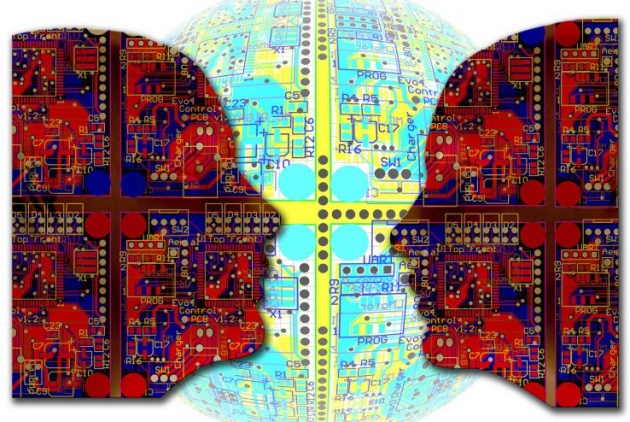
Language is a distinctly human trait. Or is it? A new wave of consumer-focused startups are now developing artificial intelligence programs that can mimic, adapt and interpret the complex semantic patterns that were previously unrecognizable to logical, mathematically driven machines.
Evolutionarily, complex linguistic patterns are one of a handful of traits that have allowed us this level of intellectual development. But because our languages cannot be broken down into straightforward, logical rules (try mapping out the process of verb conjugation in precise detail and you’ll see what I mean), it’s been a major barrier in the realm of computer science.
Select projects, like IBM’s Watson, have shown impressive feats of semantic understanding, but only now are AI startups starting to reach the consumer in meaningful ways — and investors are drooling for more. In 2014 alone, venture capital investments in artificial intelligence increased more than 300 percent over 2013. So what makes these companies so appealing?
Speech Recognition And Personal Assistants
Over the years, Apple’s ubiquitous personal assistant program Siri has evolved to become much more sophisticated, capable of understanding commands better and performing more actions with appropriate vocal inputs. Siri’s semantic understanding is impressive, and she’s not alone in the market — Google Now is just one major competitor vying for AI dominance in the personal assistant realm.
It’s appropriate that a fleet of startups is currently rising to the occasion, either producing their own intelligent voice-based assistants or developing enhancements for those that already exist. Take, for instance, Wit.ai, a tech startup that specializes in converting audible human speech into structured data that programs can then interpret — it recently received more than $3 million in VC funding.
CEO Alex Lebrun wants the open, community-based system to someday become “the Github, the Wikipedia, [or] the Bitcoin of natural language.”
Rather than trying to centrally “solve” the problem of language understanding on a technical level, Wit.ai is crowdsourcing a solution to the problem. Users take specific phrases and, using their own ideas or borrowing some from the community, create structured information that can be readily understood in algorithmic processes.
The core Wit.ai technology learns from the users that engage with it and use it regularly, and, over time, the system should be able to master the use of language for any practical technological purpose. You could almost consider it a “human to machine” language translator that develops its skills every day. Wit.ai raised $3 million in funding in October of 2014, after an undisclosed amount earlier that year from Y Combinator. It was acquired by Facebook in early 2015.
Of course, there’s always emerging competition. Consider Irish startup Aylien, whose natural language processing technology can summarize long swaths of text and even determine the emotions felt by the person who wrote it. Aylien raised more than $500,000 of funding in 2011.
One of Wit.ai’s more direct competitors, Api.ai, claims to be “the most advanced tool that allows developers to design and integrate speech interfaces into their solutions in a matter of minutes,” and similarly offers language-based solutions for developers of other projects. Itraised more than $5.6 million over three rounds of funding.
Automated Content Production
Semantic interpretation is only the first step. The next step, inevitably, is to offer a form of semantic production, or in other words, a way for machines to write articles like a human. A new wave of AI-based startups is starting to make that happen, entering “the era of the narrative,” in the words of Kris Hammond.
For example, look at Banjo, an app that purports to “instantly [organize] the world’s social and digital signals by location, giving an unprecedented level of understanding of what’s happening anywhere in the world, in real time.”
If I had to guess at what our biggest existential threat is, it’s probably [artificial intelligence]. So we need to be very careful.
Basically, it’s a form of AI that collects data from all over the web and social media to break news stories before news publishers can even catch onto them. Narrative Science similarly collects and analyzes data from things like weather forecasts and stock prices, then creates stories and conclusions based on that collected information.
Banjo has raised more than $121 million across three rounds of funding, while Narrative Science has raised a respectable $32.4 million in six rounds.
Considering the growth of the technology thus far, it seems realistic that AI programs could be writing the majority of the articles we read within the next decade. Of course, this brings up a dilemma for writers and other previously human-exclusive professionals; what happens when all our jobs are replaced by sophisticated machines? In the words of Elon Musk, “If I had to guess at what our biggest existential threat is, it’s probably [artificial intelligence]. So we need to be very careful.”
Overcoming the language barrier is a critical moment in the timeline of AI development. The wave of consumer-focused, linguistically complex AI programs is only beginning its explosion of popularity. In the coming years, our perceptions of language — and indeed, the limits of machine understanding — will undoubtedly undergo a forced revision.
In the meantime, investors are hopeful this latest fad in emergent consumer technology pays off. As fuel for countless consumer-facing applications, natural language recognition is an elementary piece of the AI puzzle, and any young startup that promises a reasonable breakthrough is likely to attract significant capital.



